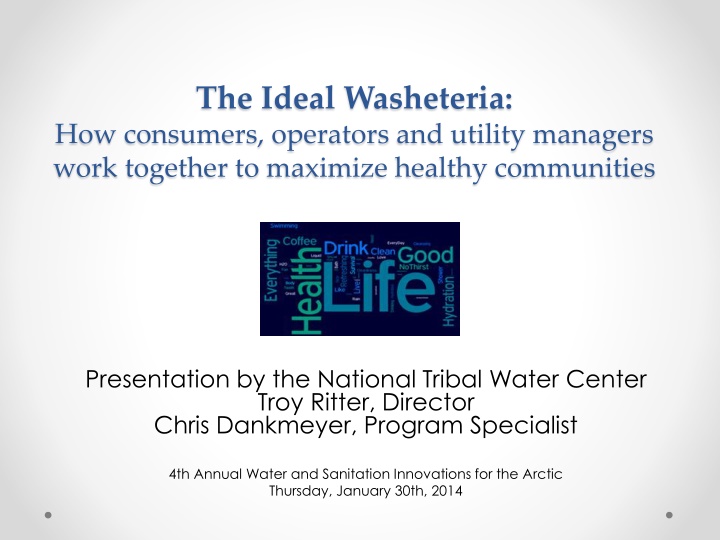
Maximizing Healthy Communities Through Washeteria Collaboration
Explore the collaborative efforts of consumers, operators, and utility managers in washeteria operations to enhance community well-being. Learn about key characteristics and behaviors promoting healthy water use, as well as strategies to limit infections in washeteria settings. Data from rural Alaska sheds light on the impact of washeteria closures on community health.
Download Presentation

Please find below an Image/Link to download the presentation.
The content on the website is provided AS IS for your information and personal use only. It may not be sold, licensed, or shared on other websites without obtaining consent from the author. If you encounter any issues during the download, it is possible that the publisher has removed the file from their server.
You are allowed to download the files provided on this website for personal or commercial use, subject to the condition that they are used lawfully. All files are the property of their respective owners.
The content on the website is provided AS IS for your information and personal use only. It may not be sold, licensed, or shared on other websites without obtaining consent from the author.
E N D
Presentation Transcript
The Ideal Washeteria: How consumers, operators and utility managers work together to maximize healthy communities Presentation by the National Tribal Water Center Troy Ritter, Director Chris Dankmeyer, Program Specialist 4th Annual Water and Sanitation Innovations for the Arctic Thursday, January 30th, 2014
2 Characteristics of the Ideal Washeteria 1. Facilitates and encourages consumers to practice the six model healthy water-use behaviors 2. Limits opportunity for washeteria-acquired infections (nosocomial)
#1 The Six Model Healthy Water-Use Behaviors
The Six Model Water-Use Behaviors* Model Behavior Respiratory Skin Diarrhea Handwashing x x x x x x x x x Bathing Household Cleaning Laundry x x x x Drinking Treated Water Sewage Disposal x *Supporting literature for this table is available upon request
#2 Limit opportunity for washeteria-acquired infections
Thomas, T. K., et al. (2013). "Washeteria closures, infectious disease and community health in rural Alaska: a review of clinical data in Kivalina, Alaska." Int J Circumpolar Health 72.
Data Sources Anecdotal evidence gathered from ANTHC/DEHE field work Lit search supported by CDC Public Health Library and Information Center o Database(s):MEDLINE, EMBASE, and Global Health:1946 to 2012 o 58 lines of criteria included in the search strategy o 4219 hits being reviewed and categorized (ongoing) Personal communications with subject matter experts
The Suspects Skin Infections Respiratory Diarrhea Staphylococcus spp. Influenza Norovirus Group A Streptococcal Streptococcus pneumoniae Clostridium difficile Scabies, Lice, Bedbugs Enterovirus Pseudomonas aeruginosa RSV Biofilms Coronavirus Fungal Infections (Tinea)
Where are they? High traffic areas Commonly touched surfaces Equipment contamination General cleanability Fomites, fomites, fomites
O&M Housekeeping Guidance
Some Knowledge Gaps What we know What we don t know Gap Washeterias present an environment suitable for pathogen transmission What pathogens are in Alaska s washeterias? In what quantities? Environmental Sampling There are a myriad of cleaning/ disinfecting protocols and research articles (4000+) What s most appropriate for washeterias in Alaska? Washeteria housekeeping best practices Washeteria O&M Manuals provide general housekeeping recommendations What s actually being done? What frequency? Is it effective? Behavior
Maximizing Health Through Behaviors Consumers Utility Management Operators


